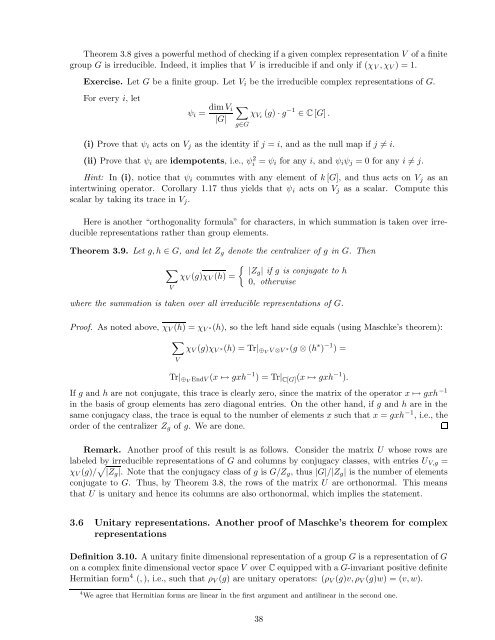Lecture notes for Introduction to Representation Theory
Lecture notes for Introduction to Representation Theory
Lecture notes for Introduction to Representation Theory
You also want an ePaper? Increase the reach of your titles
YUMPU automatically turns print PDFs into web optimized ePapers that Google loves.
Theorem 3.8 gives a powerful method of checking if a given complex representation V of a finite<br />
group G is irreducible. Indeed, it implies that V is irreducible if and only if (ν V , ν V ) = 1.<br />
Exercise. Let G be a finite group. Let V i be the irreducible complex representations of G.<br />
For every i, let<br />
ξ i = dim V i ν Vi (g) · g −1 C [G] .<br />
|G|<br />
gG<br />
(i) Prove that ξ i acts on V j as the identity if j = i, and as the null map if j ⇒ = i.<br />
(ii) Prove that ξ i are idempotents, i.e., ξ2 i = ξ i <strong>for</strong> any i, and ξ i ξ j = 0 <strong>for</strong> any i ⇒ = j.<br />
Hint: In (i), notice that ξ i commutes with any element of k [G], and thus acts on V j as an<br />
intertwining opera<strong>to</strong>r. Corollary 1.17 thus yields that ξ i acts on V j as a scalar. Compute this<br />
scalar by taking its trace in V j .<br />
Here is another “orthogonality <strong>for</strong>mula” <strong>for</strong> characters, in which summation is taken over irreducible<br />
representations rather than group elements.<br />
Theorem 3.9. Let g, h G, and let Z g denote the centralizer of g in G. Then<br />
<br />
νV (g)ν V (h) =<br />
|Zg | if g is conjugate <strong>to</strong> h<br />
0, otherwise<br />
V<br />
where the summation is taken over all irreducible representations of G.<br />
Proof. As noted above, ν V (h) = ν V (h), so the left hand side equals (using Maschke’s theorem):<br />
<br />
νV (g)ν V (h) = Tr| ∈V V V (g (h⊕ ) −1 ) =<br />
V<br />
Tr| ∈V EndV (x ⊃ gxh −1 ) = Tr| C[G] (x ⊃ gxh −1 ).<br />
If g and h are not conjugate, this trace is clearly zero, since the matrix of the opera<strong>to</strong>r x ⊃ gxh −1<br />
in the basis of group elements has zero diagonal entries. On the other hand, if g and h are in the<br />
same conjugacy class, the trace is equal <strong>to</strong> the number of elements x such that x = gxh −1 , i.e., the<br />
order of the centralizer Z g of g. We are done.<br />
Remark. Another proof of this result is as follows. Consider the matrix U whose rows are<br />
labeled by irreducible representations of G and columns by conjugacy classes, with entries U V,g =<br />
ν V (g)/ |Z g |. Note that the conjugacy class of g is G/Z g , thus |G|/|Z g | is the number of elements<br />
conjugate <strong>to</strong> G. Thus, by Theorem 3.8, the rows of the matrix U are orthonormal. This means<br />
that U is unitary and hence its columns are also orthonormal, which implies the statement.<br />
3.6 Unitary representations. Another proof of Maschke’s theorem <strong>for</strong> complex<br />
representations<br />
Definition 3.10. A unitary finite dimensional representation of a group G is a representation of G<br />
on a complex finite dimensional vec<strong>to</strong>r space V over C equipped with a G-invariant positive definite<br />
Hermitian <strong>for</strong>m 4 (, ), i.e., such that δ V (g) are unitary opera<strong>to</strong>rs: (δ V (g)v, δ V (g)w) = (v, w).<br />
4 We agree that Hermitian <strong>for</strong>ms are linear in the first argument and antilinear in the second one.<br />
38

















